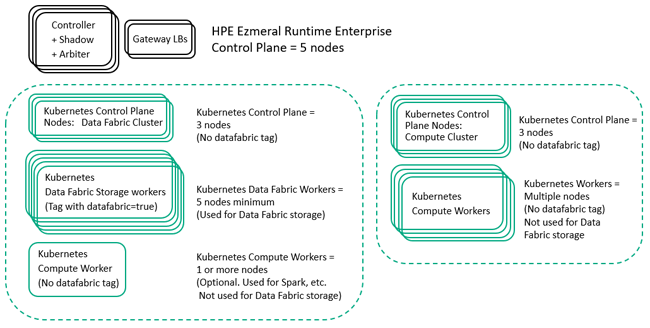Controller, Gateway, and Worker Hosts
A host is either a physical server or a virtual server, located on your premises or in a public cloud, that is available to HPE Ezmeral Runtime Enterprise. The term host and node are often used interchangeably. Nodes are hosts that are part of a cluster.
You must have a supported operating system installed on hosts before they can be used in HPE Ezmeral Runtime Enterprise. Hosts have different requirements depending on their functions. See Host Requirements.
Logical Diagram of Hosts
The following diagram illustrates a Kubernetes deployment of HPE Ezmeral Runtime Enterprise that includes a Kubernetes cluster used for compute jobs and a separate Kubernetes cluster that is an implementation of HPE Ezmeral Data Fabric on Kubernetes.

Controller Hosts
The Controller host is the host where you initially install HPE Ezmeral Runtime Enterprise. This host controls the rest of the hosts in the deployment.
In high-availability (HA) deployments, there is also a Shadow Controller host and an Arbiter host, for a total of three (3) Controller hosts.
Controller hosts are part of the HPE Ezmeral Runtime Enterprise control plane. HPE Ezmeral Runtime Enterprise control plane hosts are not part of any Kubernetes cluster.
Gateway Hosts
Gateway load balancer (Gateway LB) hosts enable access to pods or container services from an external network. See Gateway Hosts.
In high-availability (HA) deployments, there are a minimum of two (2) Gateway LB hosts. For more information about Gateway host requirements, see Gateway Hosts.
Gateway LB hosts are part of the HPE Ezmeral Runtime Enterprise control plane. HPE Ezmeral Runtime Enterprise control plane hosts are not part of any Kubernetes cluster. Gateway hosts are added to HPE Ezmeral Runtime Enterprise in a separate installation procedure.
Kubernetes Control Plane Hosts
Hosts become Kubernetes nodes in a two-phase process. First the host is added to the HPE Ezmeral Runtime Enterprise deployment. Then the host is added to the Kubernetes cluster as a Kubernetes control plane node or as a worker node.
The Kubernetes control plane nodes manage the Kubernetes worker nodes and pods in the Kubernetes cluster. For detailed information about what a Kuberentes control plane does, see Control Plane Components in the Kubernetes documentation (links opens an external website in a new browser window or tab).
In high-availability (HA) deployments that implement Kubernetes, there are a minimum of three (3) Kubernetes control plane nodes.
Kubernetes control plane nodes, formerly known as master nodes, control the Kubernetes cluster, but are not considered part of the HPE Ezmeral Runtime Enterprise control plane.
Worker hosts
Hosts become Kubernetes nodes in a two-phase process. First the host is added to the HPE Ezmeral Runtime Enterprise deployment. Then the host is added to the Kubernetes cluster as a Kubernetes control plane node or as a worker node.
Worker nodes run the containers and pods that process jobs in HPE Ezmeral Runtime Enterprise. Worker nodes are managed by the Kubernetes control plane for that cluster.
See also Data Fabric worker hosts
Data Fabric Worker Hosts
Data Fabric hosts are the hosts that have
Datafabric tag enabled. These hosts can become the Data Fabric worker storage nodes in an implementation
of HPE Ezmeral Data Fabric on Kubernetes.